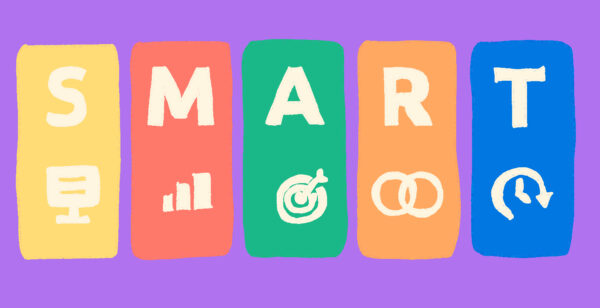SMART goals are a versatile, pragmatic, and realistic way to meet deadlines and accomplish tasks. But have you ever considered that SMART goals could also be an effective tool in people management? Dr. Heidi K. Gardner, consultant, researcher, and author of Smarter Collaboration, can point to why SMART goals lead to successful employees and successful organizations – read on to find out more.
What are SMART goals?
Dr. Gardner says that over the past decade, her team at Harvard University has been researching how the most successful companies accomplish their goals and achieve strategic business outcomes. Ultimately, she found that the highest-performing leaders use SMART goals – an acronym for goals that are:
- Specific
- Measurable
- Achievable
- Relevant
- Time-Bound
“It delineates whose expertise is absolutely needed and whose isn’t, and to design project plans to make sure those essential experts are accountable for staying on track,” Gardner tells Hive. “This hyper-intentional way of designing work by starting with the end in mind is fundamental to what we call smarter collaboration, and it leads to significant, quantifiable advantages.”
What are SMART goals for?
SMART goals, Gardner says, are for anyone – for leaders, managers, and employees. They work well with internally-focused or externally-focused goals, and they even work for performance goals, which can serve as “mini projects” underneath a larger project. In a marketing context, Gardener says, an example of a SMART goal could be: “By February 2023, our company will send out a high-quality newsletter to our top 2,000 CRM contacts in the transportation sector.” This gives a specific time frame, a measurable goal that’s achievable, relevant to the company’s needs, and time-bound, as there’s a deadline.
“While this project goal should align with a larger company goal, say, to boost sales by a certain percentage in one customer segment, its specificity helps leaders know who should contribute to the project. In this case, it might be a marketing copywriter, graphic designer, database administrator, copy editor, and the segment’s marketing manager,” she says. “An organization-wide perspective helps foster collaborative working: a key ingredient to better financial, customer, and talent outcomes.”
However, every SMART goal isn’t for everyone, as sometimes, too many cooks in the kitchen can spoil the broth. Utilizing the right people at the right time helps SMART goals get accomplished. Assigning the right roles to the right people helps achieve SMART goals more efficiently.
“No one knows everything,” Gardner says. “But when we know as many people as possible who know different things, we can tap into this expertise when it’s beneficial to answer questions and reach heights we never thought possible. Yes, through smarter collaboration, we can reach and surpass our goals, generating better solutions for clients, higher sales and revenue, and more satisfied and engaged employees.”
Using SMART goals in employee performance management
SMART goals aren’t just for projects and company goals. They’re also for employee performance management, as they’re a great way to ensure that everyone is working to the best of their abilities. Gardner says that managers should, in fact, co-create SMART goals for and with those who directly report to them.
These goals will increase personal, professional, and organizational accountability and keep employees on track. Progress towards achieving these goals can be measured using software to manage employee development or more comprehensive goal-tracking tools.
“For example, one SMART goal for a client care representative might be to increase new-customer satisfaction ratings by 10% in six months—coinciding with their higher-ups’ goals of doing the same,” Gardner says. “The representative would then be incentivized to use all the tools and resources at their disposal—including colleagues’ relevant expertise—to boost satisfaction rates. This may involve reaching out to coworkers in research and design, supply chain, and manufacturing, for example, to answer pointed questions about a product’s composition and functioning.”
Gardner also says that SMART goals can provide managers with a barometer of their employee’s work performance so they’re able to catch performance lags early and intervene appropriately.
“Beyond just trouble-shooting, managers are encouraged to train their employees on the various aspects of smart collaboration—including conflict resolution, agility, and communicating one’s collaborative value.”
Re-imagining performance through SMART goals
Implementing SMART goals with your employees goes beyond co-creating SMART goals into goal management. More than anything, Gardner says, ensure that the importance and value of the goals are communicated to employees. Rather than communicating through inputs, communicate through worth – and when you’re making SMART goals with employees, keep that mindset at the forefront.
“Many managers set goals around quotas, such as the number of articles that are written or time that’s spent responding to customer inquiries or Excel records that are completed. But the reality is this means nothing if it doesn’t translate into a meaningful achievement for the company. Your subordinates may be really efficient at a task, but if it is the wrong task or performed in a low-quality way, say, without input from experts in other areas, you’ll have simply wasted time and money.”
Rather than putting outputs at the top of your priority list, focus on deliverables, both tangible and intangible, such as productivity or time management. By seeing how well their work aligns with their SMART goals, you can assess their output secondarily, as it will improve if their processes improve.
“This helps alleviate a concern that so many managers have today,” Gardner says, “whether their remote employees are adequately performing.”





